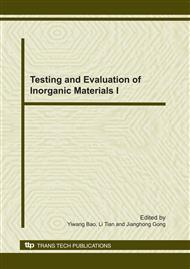p.510
p.514
p.518
p.522
p.526
p.530
p.533
p.537
p.541
Influence of Cement Coarse Particle on the Self-Healing Ability of Concrete Based on Ultrasonic Method
Abstract:
The influences of particle size and mixing content of coarse cement on the self-healing ability of concrete were researched by ultrasonic method. Damaged degree was measured through the decrease of ultrasonic head wave amplitude (UHA) before and after loading. The relationship between damaged degree and self-healing ratio of concrete was built based on the experimental results as well as the relationship between cement diameter and self-healing ratio of concrete. Analyzing results show that UHA can evaluate the damaged degree of concrete clearly. There exists a damaged threshold of the concrete during loading. Under the same mixing content of coarse cement, when the damaged degree is higher than the threshold, the self-healing ratio of concrete decreases with the increase of damaged degree and increases with the increase of coarse cement diameter, however, while the damaged degree is less than the threshold, the self-healing ratio of concrete increases with both the increase of damaged degree and coarse cement diameter.
Info:
Periodical:
Pages:
526-529
Citation:
Online since:
December 2010
Authors:
Keywords:
Price:
Сopyright:
© 2011 Trans Tech Publications Ltd. All Rights Reserved
Share:
Citation:


